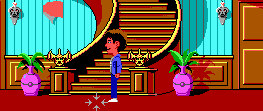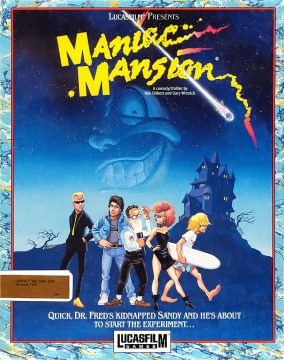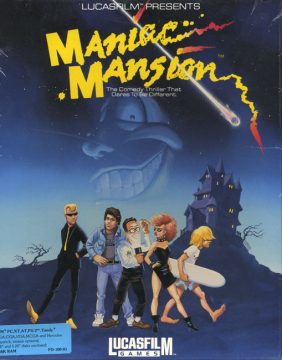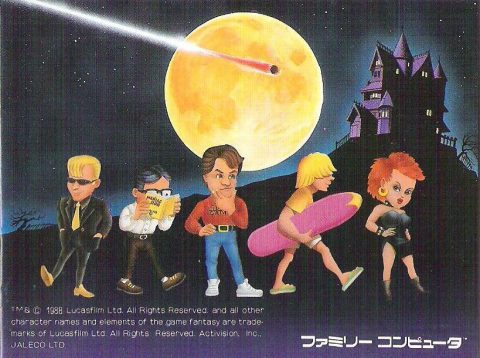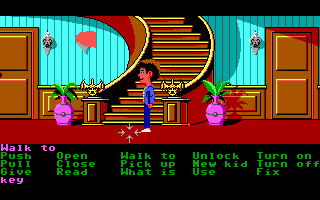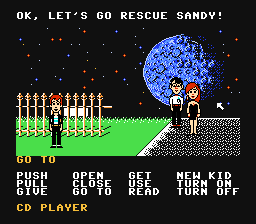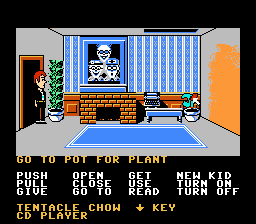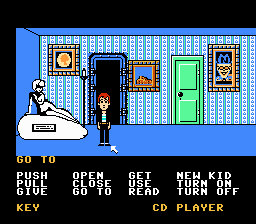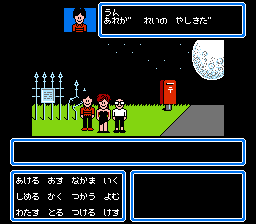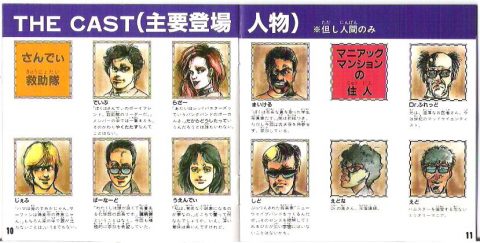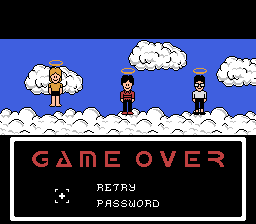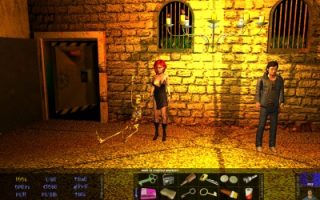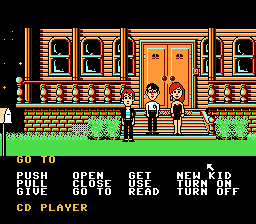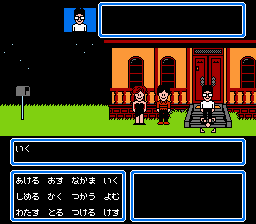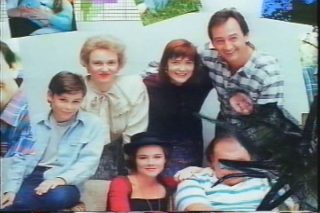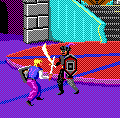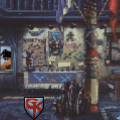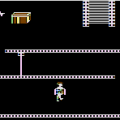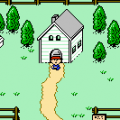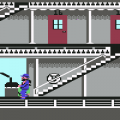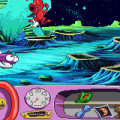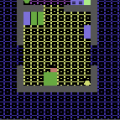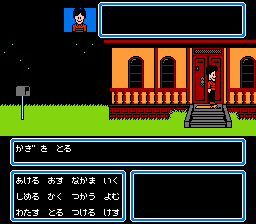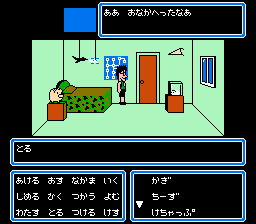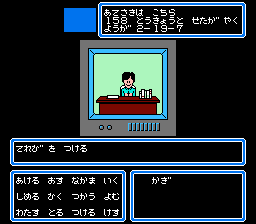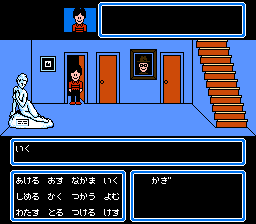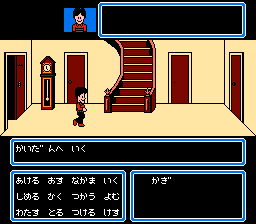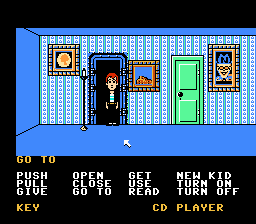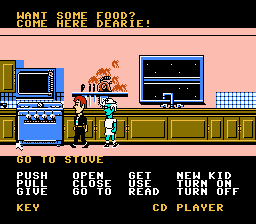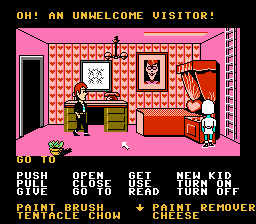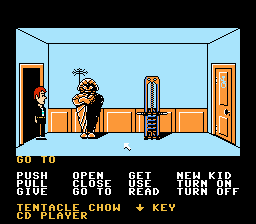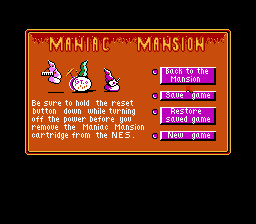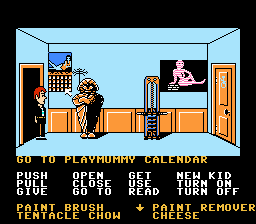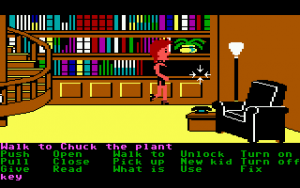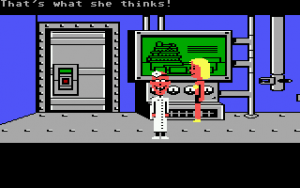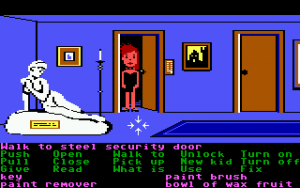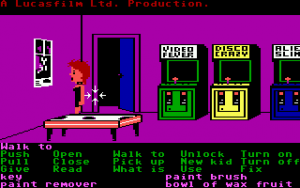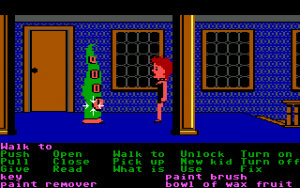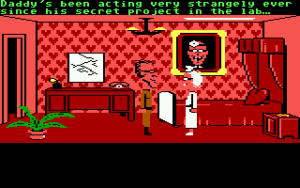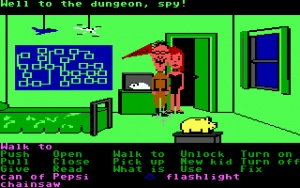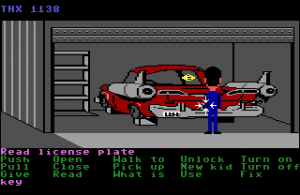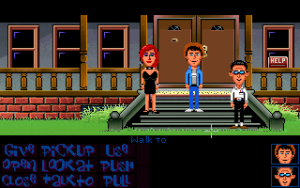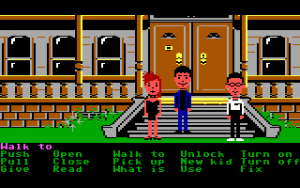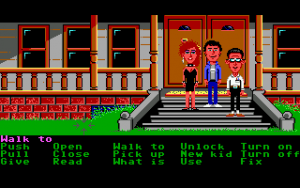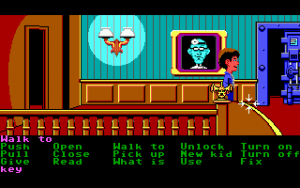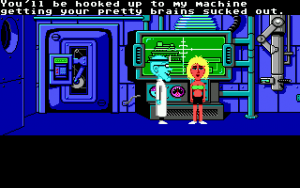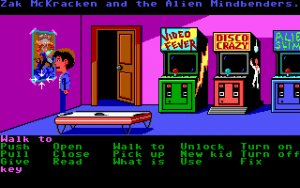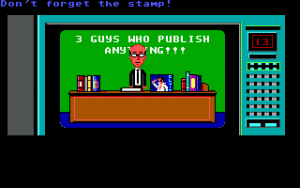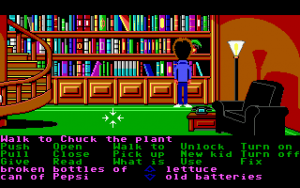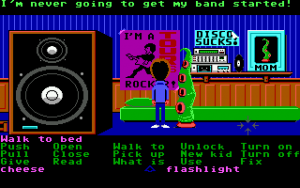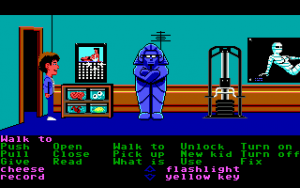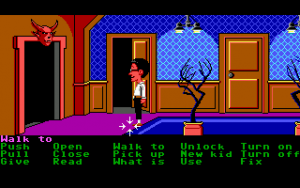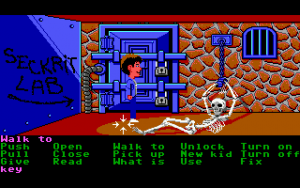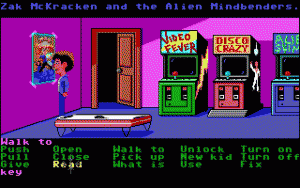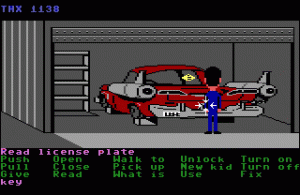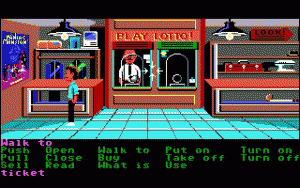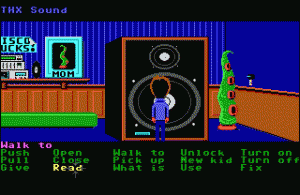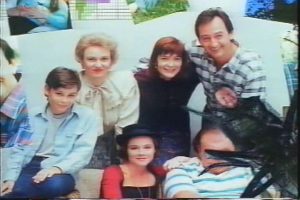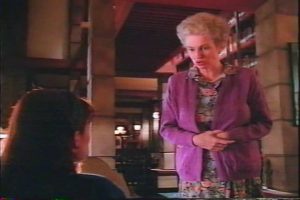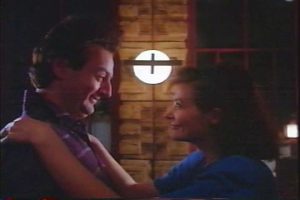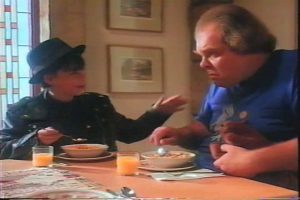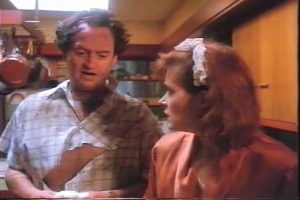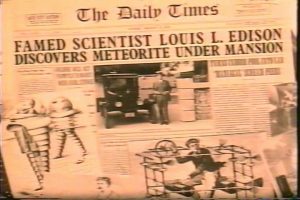- Maniac Mansion
- Maniac Mansion: Day of the Tentacle
The graphic adventure genre was born from text adventures – Colossal Cave begat Infocom’s Zork which begat Sierra’s Mystery House. Sierra was constantly pushing forward, eventually inventing King’s Quest, developing a fully visual world with a controllable avatar. Despite its advancements, the character was still controlled by the keyboard, and interaction was accomplished solely through typing. The next step was to implement a fully cursor based interface, allowing the player to point-and-click to move and interact. Although the first popular game to successfully implement this was ICOM’s Déjà Vu, the most famous was Lucasfilm’s Maniac Mansion. It was largely directed, written and programmed by Ron Gilbert and Gary Winnick, both of whom also worked on Indiana Jones and The Last Crusade: The Graphic Adventure, as well as both Monkey Island games.
Maniac Mansion begins with a meteor crash landing in the backyard of a large, rickety house. The story fast forwards twenty years, as Dr. Fred Edison, owner of the mansion, kidnaps Sandy, a local teenage girl, to conduct a number of mad, brain sucking experiments. These two events are not coincidental – the Meteor is sentient, and has taken control of the not-so-good doctor. Sandy’s boyfriend Dave is none too pleased by this, so he assembles a group of his friends to stage an impromptu infiltration and rescue her from the Edison’s basement laboratory. Dr. Fred lives in weird company, with his crazy wife Nurse Edna and military nut son Weird Ed. Even though neither of them takes too kindly to intruders, they’re equally as concerned for Dr. Fred’s deteriorating mental health, and your troupe can attempt to befriend them to provide aid for the greater good. Also inhabiting the house are two sentient tentacles – the green one, who looks fearsome but mostly just lounges around and dreams of being a rock star; and the purple one, who is actively evil and aids Dr. Fred with his schemes. There’s also Dead Cousin Ted, the mummified remains of a long deceased family member who nevertheless seems to maintain a fairly decorated living quarters.
Before Dave begins his trip into the mansion, you must pick two of his friends to join him. Although Dave has no special talents, the rest of his pals are defined by their various skills, which allow for different solutions to many of the game’s puzzles. Bernard is a tech nerd who can fix anything; Razor is a punk rock musician who can help Green Tentacle with his singing career; Wendy is an aspiring writer who can turn the Meteor’s memoirs into a work of literary genius; and Michael knows his way around a photo lab and can develop pictures to help out Weird Ed. The two other cast members are largely redundant – Syd is a new age musician who’s functionally the same as Razor, and Jeff is a wasted surfer dude who is essentially useless, since his only skill is being able to fix telephones, which Bernard can also do. You only control a single kid at a time, and each explores the mansion independently, although you can switch to any other member via the “New Kid” command.
There are a total of three “good” endings (with a number of variations) based on who you bring with you. It’s a very freeform approach to design that most successive adventure games – further LucasArts games included – tended to leave by the wayside for a more focused experience. It allows for tons of replayability, because you need to play through the whole game at least twice to see all of the possible endings, much less find the multiple solutions to the puzzles.
It’s just as well, since Maniac Mansion isn’t a terribly long game. Although the mansion is quite large, there are really only a few major obstacles to overcome – open the two locks to get into the secret lab, find some way to distract the Purple Tentacle, and get rid of the Meteor. But while LucasArts games had a tendency to be very player friendly (at least compared to Sierra games), this design philosophy didn’t kick in until Loom. In Maniac Mansion, it is entirely possible to find yourself in a dead end, requiring that you reload an earlier save, or possibly even restart. You can also get your characters killed, although most of these require some conscious effort on the player’s part. Some of them are almost Easter eggs unto themselves – try stealing Ed’s hamster, sticking it in the microwave and giving him the charred remains, or playing the record of Tentacle Mating Calls in the presence of the Green Tentacle, both rather silly ways to bump off the kids. Sending one of them to their grave doesn’t necessarily mean you’ve lost, but if their skill was vital to solve a puzzle, you’re basically out of luck. There are also a few ways to blow up the entire mansion, usually by senselessly mucking with the Edison’s nuclear reactor, which will obviously bring the entire game to an end.
The action also flows in real time, with scripted events occurring at specific points. Sometimes this simply triggers cutscenes (often documented as the first time they were implemented in an electronic game) as the Edisons talk to each other, while at other times it will send one of the members wandering around the mansion. You’ll learn this quickly if you enter the kitchen at the beginning and find Nurse Edna rummaging through the refrigerator. You can choose to either wait a few moments until she leaves, or simply run away from her – due to a programming glitch (present in all versions) she’ll simply disappear if you leave the room. Alternatively, getting caught means you’ll get tossed in the dungeon, which is very easy to escape from. Unless you’re using a walkthrough, the initial playthrough might be a wash unless you have an idea of when these events occur and how to react to them. (Make sure to steal that package before Weird Ed can get to it, because it makes the game a lot easier.) The puzzles themselves aren’t really very difficult, as most simply revolve around finding specific items and knowing where to use them, and none of their uses are too obscure.
Given that Maniac Mansion was one of the first completely cursor driven adventure games, there are a lot of quirks which might seem odd in retrospect. For example, the game will not indicate hotspots when you highlight them – you need to click it first, or use the “What Is” command, which will allow you to comb the screen for stuff you can interact with. There is no “Look” command – about the closest you can do is “Read” certain items. As a result of the genre’s roots in text adventures, there are a number of verbs that feel extraneous, like “Turn On/Off”, “Fix”, “Lock/Unlock” and such, as later adventure games simply replaced them with an all purpose “Use” command. There is also no way to “Talk” to anyone, as all character interactions are initiated by the mansion inhabitants. The inventory is listed as text beneath the commands, although only a small number are available at a single time and need to be scrolled through. There are a lot of unnecessary items too, even though you can carry an unlimited amount of stuff. The inventory is not shared between the characters, so they’ll need to be in the same room to give items to one another. There are no dialogue trees either, so the kids are mostly just defined by their looks and their skills – otherwise, they don’t have much personality. They all look a bit weird, with thin, stick figure bodies and large heads with very, very silly grins.
Still, even though its functionality is fairly rudimentary, the game possesses a really weird faux horror vibe that’s easy to find engrossing, even years after its publication. It’s not nearly as a macabre as the blood-splattered logo might suggest, but there’s an inherent silliness in the premise, as well as many of the puzzle solutions. Some of it is intentionally baffling – there’s a staircase that simply reads “Out of Order”, which can’t be climbed (nor fixed) no matter what you do. And then there’s Chuck the Plant, a household plant who serves no great significance other than somehow having its own name. This little bit of greenery has since become a running joke in many future games, LucasArts or otherwise. So while Maniac Mansion is often overshadowed by its sequel, these elements, combined with its less linear design, still make for a perfectly playable experience.
Maniac Mansion was originally developed for the Commodore 64 and Apple II in 1987, and ported to the IBM PC in 1988. These versions are essentially identical, featuring blocky low-res 16 color graphics. It’s not a pretty sight. The only real difference between these versions are due to the sound capabilities of each computer, with the Apple II and PC speaker sounds losing out to the SID chip of the Commodore 64. There’s barely any music or sound effects though, so it’s not a big deal.
An enhanced version was also released later in 1988 for the Commodore Amiga, Atari ST, and again for the IBM PC. It features greatly improved graphics, with double the resolution and far more detail in both the characters and backgrounds, even though it still sticks to a 16 color limit. Although the Edisons were originally flesh colored, this version turns them all blue, for some reason or another. The PC version is still stuck with lousy PC speaker sound though. Functionally, these enhanced versions are the same as the original release, except the Star Wars poster in the arcade is replaced with a Zak McKracken poster. If you try to read it, your character will muse how they could never find a use for the gas can on Mars. This is a reference to the chainsaw found in the kitchen in Maniac Mansion, which is useless because there’s no gas anywhere. Both PC versions, as well as the Amiga and Atari ST versions, utilize a copy protection scheme, which requires that you look in the manual to open up the blast door on the second floor. In all of the other versions, it’s unlocked and stays open.
Maniac Mansion was also ported to 8-bit Nintendo systems, but the Japanese Famicom and American/European NES versions are completely different. The NES version was developed by Realtime Associates (who also ported LucasArts’ Loom to the Turbografx-16) and published by Jaleco. The graphics are totally different – better than the first computer release but not quite as good as the enhanced version – but it controls smoothly and quickly. The characters are actually a bit better proportioned in this version, even though they’re animated somewhat awkwardly. The Edisons are still blue, and Weird Ed now wears a garish purple beret, and looks a bit less freaky. Some of the rooms have been condensed into a single screen, but the puzzles and layout are faithful. Using the controller isn’t as handy as using a mouse, although it’s more than suitable. Some of the extraneous verbs are removed, like Fix and Unlock, and you can cycle through the three most used verbs with the Select button. But most importantly, it will automatically identify items when you place a cursor over it, eliminating the need for the “What Is” command. In all of the other versions, you can also need to click the mouse button a second time to confirm your action, whereas that is no longer needed here. It features a battery backup save, although since there’s only one slot, it is perfectly possible to screw yourself over.
The best feature, though, is the soundtrack. Each character has their own specific theme (which can be turned on and off via the CD player in their inventory), and all of them are excellent, because they add a lot of personality to what are otherwise blank slates. Dave’s theme is upbeat rock, Wendy’s is classical, Michael’s is funky, and Razor’s about as close as you can get to heavy metal on the NES. The music was all supplied by George Sanger and his studio, Team Fat, who provided soundtracks for many computer games of the era, including Wing Commander and The 7th Guest.
The NES port would be the definitive version, if it weren’t for the censorship. With Nintendo of America gravely concerned about its family friendly image, it demanded the removal of several elements. Dr. Fred’s speeches were toned down, removing any mentions of “sucking pretty little brains”, and Nurse Edna’s sexual innuendoes were gone entirely – lines were changed from “How silly of me! I should’ve tied you to my bed, cutie!” (if you’re a male character) or “You’re lucky you’re not a boy, or you’d be in BIG trouble right now!” (if you’re female) to “Just wait until I talk to your mother.” or “You’ll be safe here until the police come.”
The note scribbled on Ted’s wall was changed from “For a good time call Edna” to simply “Call Edna”. The reclining nude statue in the hallway, and the suggestive mummy picture and Playboy calendar in Dead Cousin Ted’s room, are all gone. The skeleton is the dungeon is missing too – apparently Nintendo thought it somehow implied that Dr. Fred was a cannibal. The arcade game Thrill Kill was renamed to Tuna Diver, tying in with the amusing G-rated insult “tuna head” (reportedly coined because the developers were unable to use “shit head”, even in the original computer releases). In the retail version, you can still microwave Ed’s hamster, but Nintendo later found out about this after the game hit the market, so it was removed from the European version. What’s particularly odd about all of these changes is that the uncensored version was exhaustively featured in an issue of Nintendo Power, so many players were exposed to some of these elements anyway. It’s possible to disassemble the NES ROM and import it into ScummVM, which adds mouse control and a better save system, although as of present the color palette is a little screwed up.
The Famicom version, released a year earlier in Japan and developed by Jaleco themselves, is a substantially worse port. The graphics are, again, totally different, and the characters have been redrawn to look smaller and cuter. All of them, what with their empty eyes and vacant smiles, look like they jumped out of a Cathy comic strip. This is the only version to have a real Game Over screen, which shows the characters as angels and looks particularly ludicrous. The box cover shows them all as super deformed dwarves, although at least there’s some cool artwork in the manual. The rooms are even more compact than the NES version, and the ones that are multi-screen don’t scroll at all. Various background details are missing. (Chuck the Plant is gone entirely, as if the programmers didn’t get the joke.) Sandy now wears a full dress instead of a tube top, and Weird Ed looks more like a stereotypical nerd, although it does have the nude statue that was taken out the NES version.
There are other small changes due to the localization – the dime becomes a 100 yen coin, and the publishing agency has an address in Tokyo (actually the address of Jaleco’s HQ). There’s even a Japanese style mailbox in the first screen, which doesn’t entirely make sense, because there’s a regular mailbox in front of the porch two screens over. Outside of a few original tunes here and there (and an especially aggravating “Pause” ditty), most of the game is played without music, much like the PC versions. The only noises are the annoying footstep sound effects when your character shuffles from place to place.
Unlike the NES version, the characters walk slowly and awkwardly. The hotspots don’t give descriptions if hovered over, but you can see them holding down the B button and highlighting them. There’s no save system, instead forcing you to work with 104 character passwords, making them one of the longest of any game on the system.
In 2004, a group of fans developed Maniac Mansion Enhanced with Adventure Game Studio. Although most of the visuals are based off the enhanced PC version, the rest of the graphics have been totally redone in 256 colors, and the whole game looks substantially better. The interface has been updated to mimic its sequel, Day of the Tentacle, condensing the actions into nine verbs, adding visual icons for all inventory items, and implementing the context sensitive right mouse button. With the addition of a “Look” command, many items have newly written descriptions, although several just trigger generic comments which differ depending on which character you use. There’s also music throughout the game, mostly borrowed from Day of the Tentacle, which changes on location rather than the characters used like the NES game. A few minor puzzles and inconsistencies are fixed too, although most of the game is identical. It’s an excellent effort, and well worth playing.
There are two more fan remakes of Maniac Mansion currently in the works – Meteor Mess 3D aims to convert the whole game into 3D, which frankly looks hideous. More pleasing to the eye are the preview screenshots for Night of the Meteor, which adopts the look of Day of the Tentacle for the original game. Neither version is looking up to a release very soon, though.
Comparison Screenshots
Maniac Mansion: The TV Show
Maniac Mansion was somehow turned into a sitcom, which was produced in Canada in 1990. There were 66 episodes in total for the Family Channel, a cable network that, at the time, had very low penetration. It has since morphed into ABC Family.
Maniac Mansion is only very, very loosely based on the LucasArts game. It ditches the whole bit with the teenagers and just focuses on the Edisons, except the Edisons are nothing like they are in the game. Sure, the head of the household is named Fred, he’s a mad scientist, and there’s a meteor in his basement (which isn’t sentient like the games), but that’s about all they have in common. The rest of the family is completely different, albeit with some quirks due to his experiments – his four year old son was turned into a hulking, mentally handicapped giant with an annoying falsetto voice, and his brother-in-law was turned into a fly. None of their names rhyme with “ed”, as they should. The developers of the game had little hand in the TV show’s production, naturally.
The quote on the cover of the sole VHS tape release, “The Love Collection”, says that New York Post claims it’s “The ‘90s equivalent of The Addams Family”. It isn’t. It has none of the same horror-fueled charm as the Addams, nor even the schlocky atmosphere of the game. The house isn’t even so much a mansion as just kinda large, and the family certainly isn’t crazy enough to be considered maniacs. Anyway, it’s a pretty standard sitcom, so the family faces dilemmas which they handle in humorous ways, and then everything’s happy at the end. Some consider it a spiritual successor to the Canadian sketch show SCTV, since a few of the same people worked on it. It stars Joe Flaherty (also known for his role as the crazy dad in the excellent Freaks and Geeks) as Fred and was created by Eugene Levy (Jim’s dad from the American Pie movies). Despite its comedy roots, the show really isn’t very funny outside of its slightly offbeat premise.
